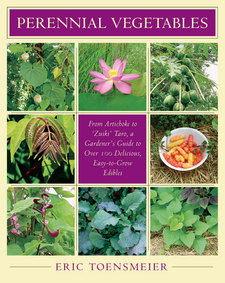
Perennial vegetables
 Permaculture books trip over
themselves to toss out the names of intriguing perennial vegetables,
but the books are short on specifics of where and how these vegetables
can be grown. When I heard that Eric Toensmeier (co-author of Edible Forest Gardens) had written a book called Perennial
Vegetables, I
knew I'd fond the holy grail, but I put off reading Toensmeier's book
for one simple reason --- I knew that I'd want to buy every vegetable
listed. So, be forewarned --- don't pick up this book unless
you've got $100 or more burning a hole in your pocket.
Permaculture books trip over
themselves to toss out the names of intriguing perennial vegetables,
but the books are short on specifics of where and how these vegetables
can be grown. When I heard that Eric Toensmeier (co-author of Edible Forest Gardens) had written a book called Perennial
Vegetables, I
knew I'd fond the holy grail, but I put off reading Toensmeier's book
for one simple reason --- I knew that I'd want to buy every vegetable
listed. So, be forewarned --- don't pick up this book unless
you've got $100 or more burning a hole in your pocket.
Perennial
Vegetable
provides cultivation information for over 100 plants that are grown for
edible leaves, shoots, tubers, and more. In this lunchtime series, I've picked out the crops that I find the most
intriguing, but I highly recommend that you read the book yourself,
especially if you live further south than zone 6 --- over half of the
species like warmer temperatures, so I skipped over them. My list
is also low on tubers because we don't eat that may of them and I'm
very happy with our potatoes and sweet potatoes. Tuber-lovers
should look up Perennial
Vegetables to
read about additional crops like lotuses, skirret, Jerusalem artichokes, and Chinese yams.
Finally, if you want to
get a head-start on checking out which plants might suit your climate,
you can go directly to Eric Toensmeier's website and find plant lists for
various parts of the U.S., a list of other books to read, and sources
for perennial vegetable seeds and starts. Or drop a comment here
to let me know which perennial vegetables you've tried in your own
garden.
| This post is part of our Perennial Vegetables lunchtime series.
Read all of the entries: |
Want more in-depth information? Browse through our books.
Or explore more posts by date or by subject.
About us: Anna Hess and Mark Hamilton spent over a decade living self-sufficiently in the mountains of Virginia before moving north to start over from scratch in the foothills of Ohio. They've experimented with permaculture, no-till gardening, trailersteading, home-based microbusinesses and much more, writing about their adventures in both blogs and books.
Want to be notified when new comments are posted on this page? Click on the RSS button after you add a comment to subscribe to the comment feed, or simply check the box beside "email replies to me" while writing your comment.
